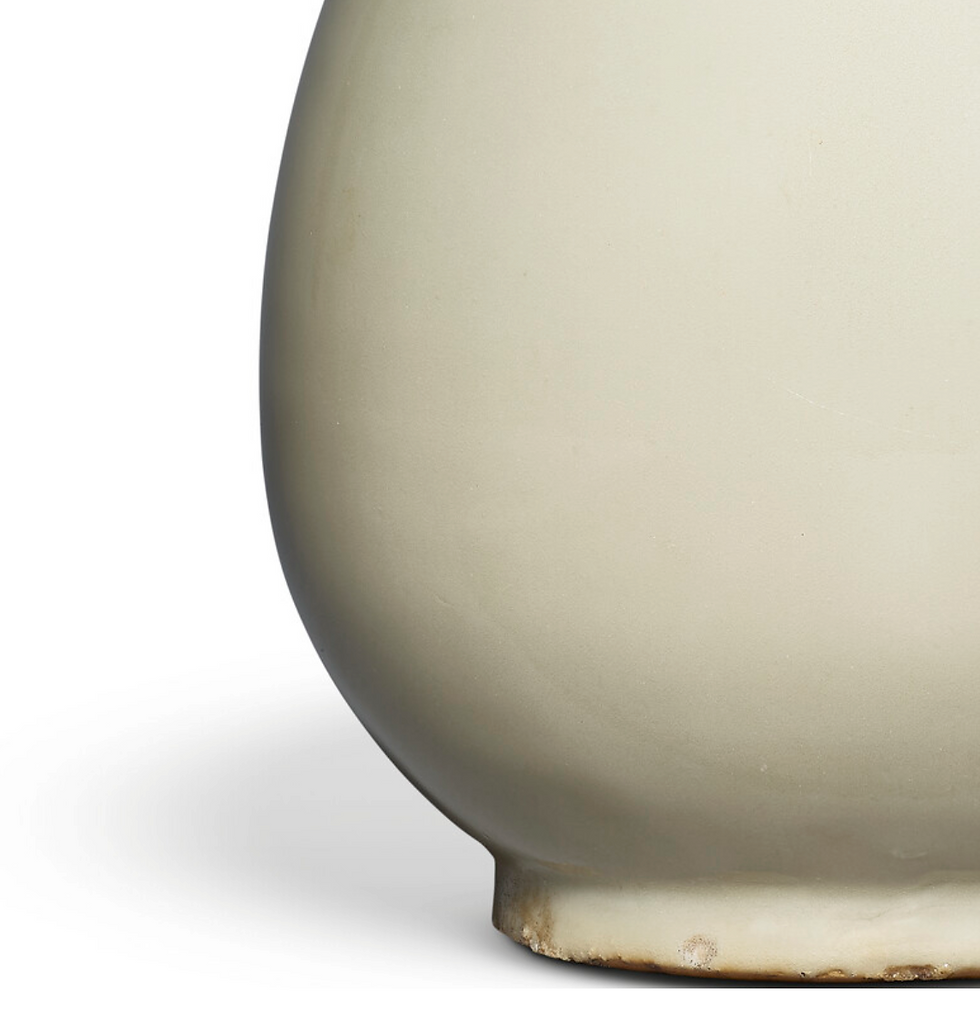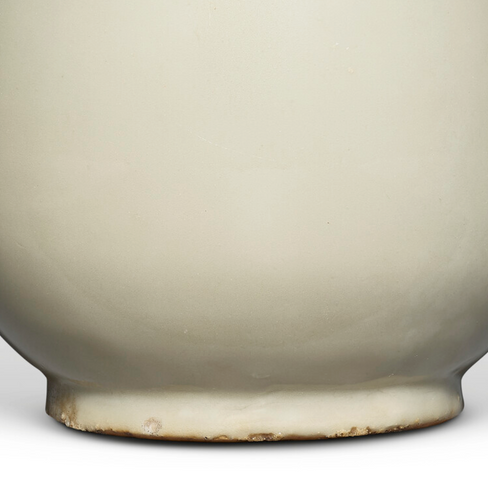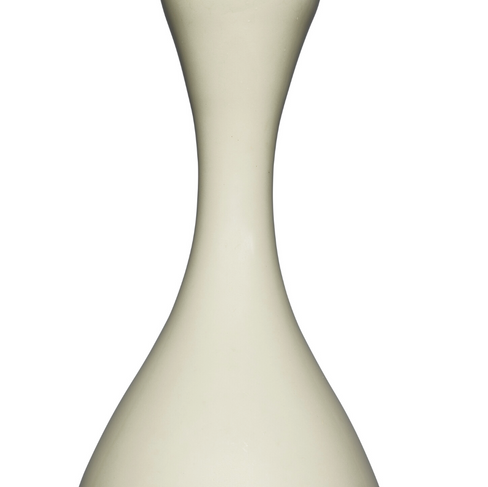拍賣筆記 vol.163 佳士得香港:金代耀州窯月白釉長頸瓶 - A Jin Dynasty Yaozhou Moon-White Glazed Vase
- SACA
- 1 day ago
- 5 min read

非常顯赫的展覽紀錄,特別是浦上蒼穹堂父子的山口縣浦上記念館。耀州窯的瓶子不多,小山富士夫的《宋磁》一書中有一件十分重要的刻花瓶,是耀州窯的代表作。近期月白因為素雅而受到中國藏家的青睞,相信在拍賣中將會有很大的爭奪。
東京顯赫珍藏
金 耀州窯月白釉長頸瓶
JIN DYNASTY (1115-1234)
估價:港元 800,000 – 港元 1,200,000
11 1⁄2 in. (29.1 cm.) high

出版
大阪市立東洋陶磁美術館,《The Masterpieces of Yaozhou Ware》,大阪,1997年,圖版103號
展覽
山口縣立萩美術館・浦上記念館,萩市,1997年10月25日-12月21日
大阪市立東洋陶磁美術館,《The Masterpieces of Yaozhou Ware》,大阪,1998年1月10日-2月22日,103號
愛知縣陶磁美術館,瀨戶,1998年4月4日-5月10日
瓶長頸,撇口,圓腹下垂,圈足。通體施月白釉,形制清麗脫俗,釉色純淨別致。
比較一十分相似的月白釉長頸瓶,先後為高登伉儷、藍理捷珍藏,並出版於藍理捷編著《Chinese Ceramics and Works of Art: The Collection of Dr. & Mrs. Marvin L. Gordon》,紐約,2009年,圖版14號;另一例月白釉者尺寸略小,曾於香港藝術館展出,載於《關氏所藏宋代陶瓷》,香港,1994年,頁220-221,圖版92號;及出光美術館藏一白釉長頸瓶,見《中國陶磁:出光美術館藏品図録》,東京,1987年,圖版84號。

常見問題:金代耀州窯月白釉長頸瓶
本件描述的瓷器屬於何種器型?其年代為何?
一件長頸瓶,其瓶口外撇,圓腹收足,底承圈足,屬耀州窯製品,通體施一層柔潤潔淨的月白釉,器形端雅,出自中國金代(公元1115年至1234年)之作。
此件耀州窯瓶具備哪些主要特徵?
該瓶呈優雅的梨形瓶身,漸收為細長的頸部,瓶口微外撇,通高約29.1公分(11½吋),全器罩以清澈柔潤的月白釉。其造型挺拔秀麗,釉色潔白純粹,展現出極致的製瓷工藝與審美品味。
本件耀州月白釉長頸瓶之估價為何?
此瓶估價介於港幣800,000至1,200,000元之間,顯示其珍罕程度與市場價值。
此瓶曾否出版或展覽?
是,此瓶曾多次刊載並展出。1997年曾刊於大阪東洋陶瓷美術館出版之《耀州窯名品展圖錄》(編號103),並於1997年在萩市的「萩浦上美術館」展出,1998年再於大阪東洋陶瓷美術館及愛知縣瀨戶市陶瓷美術館展出,展覽歷程完備,學術價值顯著。
是否有與此類似的器物可作比較?
說明中列舉數例可資參考:一件極為相似的月白釉長頸瓶曾屬美國戈登伉儷舊藏,著錄於《Chinese Ceramics and Works of Art: The Collection of Dr. & Mrs. Marvin L. Gordon》(2009年);另有一件尺寸略小之月白釉例,曾展於香港藝術館,並見於《關氏藏宋瓷》(1994年);又一件白釉長頸瓶藏於出光美術館,著錄於《出光美術館藏中國陶瓷選》(1987年),均為研究本瓶之參考標準器。
所謂「月白釉」有何特點?
「月白釉」為本器一大特色,釉色被形容為「清澈柔潤」、「純淨獨特」,此釉色不僅提升了器物的視覺美感,更因其工藝難度與稀有性而顯得尤為珍貴。
所謂「東京名門舊藏」對於器物來源有何啟示?
「東京名門舊藏」暗示此瓶來自一個具聲望之重要私人收藏。此類來源常為拍場與學界所重,能大幅提升器物之可信度與收藏價值。
出版與展覽紀錄對於本瓶之意義為何?
詳實之出版與展覽紀錄顯示此瓶在中國陶瓷史上具有重要地位,其被列入專業圖錄並於多所公立美術館展出,顯見其學術價值與藝術地位獲得廣泛肯定,實為耀州窯月白釉器之代表作。

Property from a Distinguished Tokyo Collection
A VERY RARE YAOZHOU MOON-WHITE GLAZED VASE
JIN DYNASTY (1115-1234)
Estimate
HKD 800,000 – HKD 1,200,000
A VERY RARE YAOZHOU MOON-WHITE GLAZED VASE
JIN DYNASTY (1115-1234)
11 1⁄2 in. (29.1 cm.) high
LITERATURE
The Museum of Oriental Ceramics, The Masterpieces of Yaozhou Ware, Osaka, 1997, Catalogue, no. 103
EXHIBITED
The Hagi Uragami Museum, Hagi, 25 October - 21 December 1997
The Museum of Oriental Ceramics, The Masterpieces of Yaozhou Ware, Osaka, 10 January - 22 Febrary 1998, no. 103
The Aichi Prefectural Ceramics Museum, Seto, 4 April - 10 May 1998
The elegant pear-shaped body tapers to a tall, slender neck rising to a slightly flared mouth, the base rounded into a short ring foot, covered overall with a clear, soft moon-white glaze.
Compare with a very similar vase from Dr. and Mrs. Marvin L. Gordon, illustrated in J. J. Lally, Chinese Ceramics and Works of Art: The Collection of Dr. and Mrs. Marvin L. Gordon, New York, 2009, no.14; and another moon-white glazed one published in Song Ceramics from the Kwan Collection, Hong Kong Museum of Art, 1994, pp.220-221, no.92; and one covered in white glaze, in the Idemitsu Museum, published in Chinese Ceramics in the Idemitsu Collection, Tokyo, 1987, pl.84.

Frequently Asked Questions: Jin Dynasty Yaozhou Moon-White Glazed Vase
1. What type of ceramic piece is the focus of this description, and from what dynasty does it originate? This description focuses on a long-necked vase with a flared mouth, round body, and ring foot, crafted from Yaozhou ware and featuring a distinct moon-white glaze. It originates from the Jin Dynasty, which ruled from 1115 to 1234 AD.
2. What are the key characteristics of this specific Yaozhou vase? The vase is described as having an elegant pear-shaped body that narrows into a tall, slender neck with a slightly flared mouth. It stands at a height of 11 1/2 inches (29.1 cm) and features a clear, soft "moon-white" glaze covering its entirety. The shape is noted for its refined and graceful quality, and the glaze for its pure and distinctive appearance.
3. What is the estimated value of this Jin Dynasty Yaozhou vase? The estimated value of this particular Yaozhou moon-white glazed long-necked vase is between HKD 800,000 and HKD 1,200,000.
4. Has this vase been previously published or exhibited? Yes, this vase has been both published and exhibited. It is documented in "The Masterpieces of Yaozhou Ware" exhibition catalogue published by The Museum of Oriental Ceramics, Osaka, in 1997 (catalogue number 103). It was also exhibited at the Hagi Uragami Museum in Hagi (1997), The Museum of Oriental Ceramics in Osaka (1998), and The Aichi Prefectural Ceramics Museum in Seto (1998).
5. Are there any comparable examples of this type of vase? The description references several comparable examples. One very similar moon-white glazed long-necked vase was previously part of the collection of Dr. and Mrs. Marvin L. Gordon and published in "Chinese Ceramics and Works of Art: The Collection of Dr. & Mrs. Marvin L. Gordon" (2009). Another slightly smaller moon-white glazed example was exhibited at the Hong Kong Museum of Art and featured in "Song Ceramics from the Kwan Collection" (1994). Additionally, a white-glazed long-necked vase from the Idemitsu Museum collection is noted as a comparison in "Chinese Ceramics in the Idemitsu Collection" (1987).
6. What is notable about the "moon-white" glaze mentioned in the description? The "moon-white" glaze is highlighted as a significant feature of this vase, described as "clear and soft" and "pure and distinctive." This suggests that the quality and color of the glaze are particularly noteworthy and contribute to the aesthetic appeal and rarity of the piece.
7. What does the mention of a "Distinguished Tokyo Collection" suggest about the provenance of this vase? The phrase "Property from a Distinguished Tokyo Collection" indicates that this vase originates from a reputable and likely significant collection in Tokyo. This can often add to the prestige and desirability of an antique or work of art.
8. What does the inclusion of publication and exhibition history indicate about the significance of this Yaozhou vase? The detailed publication and exhibition history of this vase underscores its importance within the field of Chinese ceramics. Its inclusion in museum exhibitions and scholarly publications signifies that it is considered a significant example of Jin Dynasty Yaozhou ware, worthy of study and public display.
















Comments